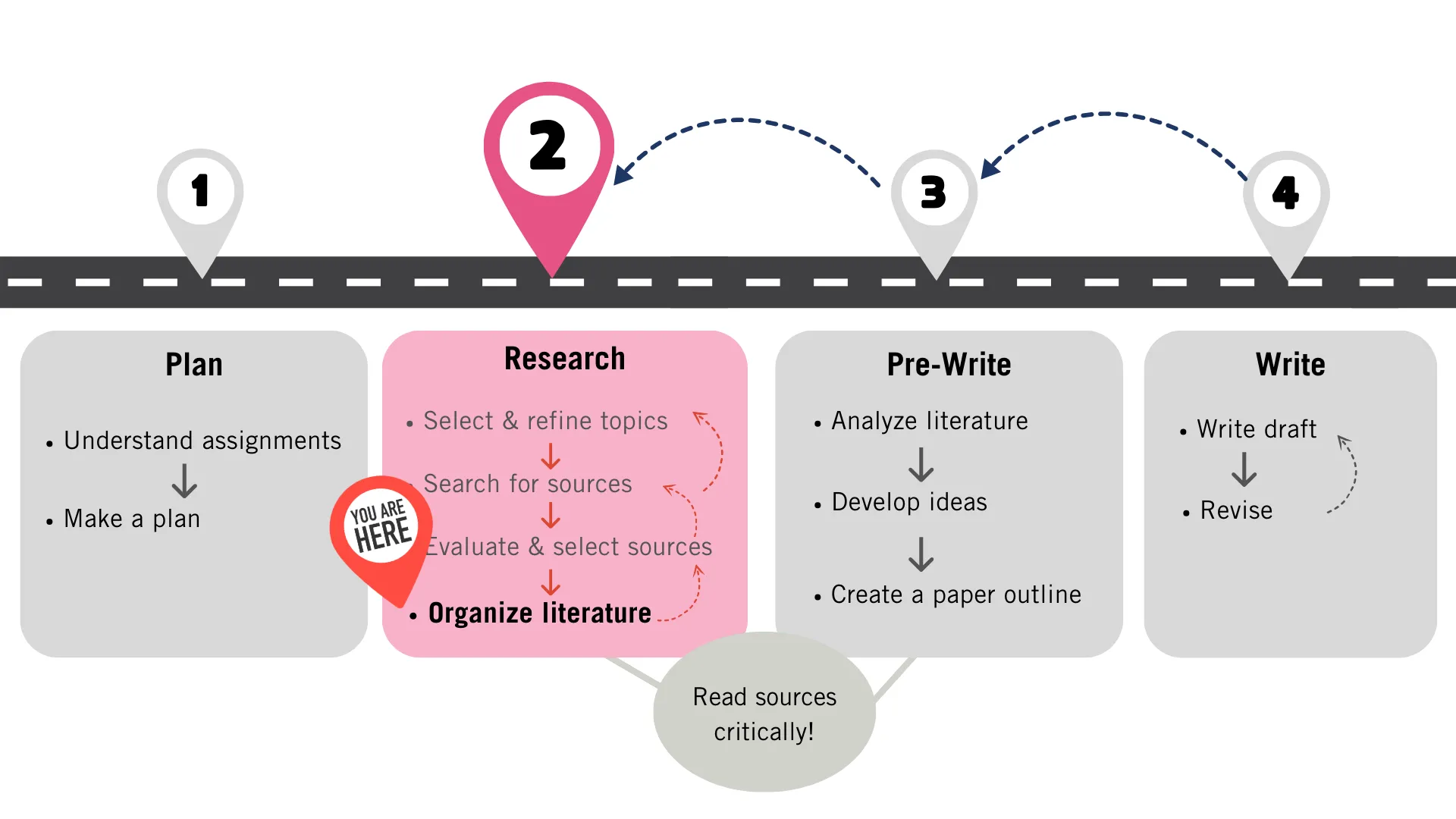How to Organize Literature
This Resource Page will help you:
- Find strategies to record basic information from sources to organize them and create a reference list
- Find a system to organize your notes and key information from the sources you have read to develop the main ideas for your literature review

Introduction
Once you have gathered the relevant literature for your assignment and read it in detail, you need to organize key information and notes systematically to compare and contrast study results, methods, etc. This organized system will prepare you to analyze the information and develop the main ideas for your assignment. In addition, it will help you determine whether additional literature search is needed or if you need to further refine your topic.
If you need help on how to find sources for your literature review, or how to read critically, please refer to How to Find Sources for Assignments resource page and How to Read Critically.
How can I Organize Basic Information?
For each source you read, first you need to record basic information such as authors’ names, title of the source, and publication year. This information can help you keep track of all the sources collected, but also prepare the reference list that will be featured at the end of your assignment.
In many cases, you need to record and organize the following basic information:
- Authors’ name(s)
- Publication year
- Title of the source
- Name of the “place” where the source is located (e.g., journal, book, website)
- Volume and Issue number if applicable
- Publisher
Method 1: Use a Spreadsheet
Download this template spreadsheet and use it to record and organize the bibliographic information of the sources you found. It will help you keep track of the sources collected. At the top, you’ll find an example of how to use this spreadsheet.
Method 2: Use a Reference Management Software
RefWorks, Zotero, Endnote, and Mendeley are appropriate tools for automated reference organization. You can refer to UofT’s citation management software page for more information and links to the above tools.
Below are examples of how to organize basic information using RefWorks and Zotero:
Find a System to Organize your Notes and Key Information
Apart from the basic information of the literature you have read, you also need to record the key content and your notes of each source, which cannot be automatically captured by reference management tools. The aim of this stage is to form a literature review system (e.g., in a table format) that helps you ensure that the important information and ideas from all the sources are effectively recorded and can be visualized all together.
Here are some important components from the literature and your notes that you might want to record:
- Focus and aim of study
- Research questions / hypotheses
- Field (e.g., psychology, language education)
- Theoretical framework
- Type of publication / study (e.g., empirical or theoretical study)
- Methodology (e.g., type of methodology, quality of research design)
- Participants
- Type of setting (e.g., geographical context, professional and social context)
- Findings & Discussion
- Date of study / publication
- How the study is related to your assignment topic
- Other reflections and comments
Tip: The information to be included in your records should be based on what you believe is relevant to your assignment topic or research question. For instance, if your topic focuses on a specific population, it is important for you to record the details about the study participants of the sources you have read.
Here is an example of how you can create a literature review system on a spreadsheet to organize all the important information and find connections among sources:
- Research question: What are the experiences and perspectives of undergraduate students and teaching staff on the assessment practices in online mathematics and statistics courses?
Download this template spreadsheet and use it to record and organize the key information of the sources you found + your notes about the relevant points from each source after reading them. It will help you when you analyze your sources and need to develop ideas for your assignment. At the top, you’ll find an example of how to use this spreadsheet.
Why Organize Key Information and Notes Systematically?
A systematic organization of key information and notes will equip you to perform a sound analysis of your sources. For instance, by looking at the columns in your table, you can identify patterns, similarities, differences, and gaps among the results of the studies you’ve read. Here are sample observations that might emerge from looking at your table:
- Do all the studies reach similar results?
- Why / Why not?
Are there any commons threads that might explain these similar /different findings?
E.g., studies with similar findings used similar methods or participant populations, etc. E.g., studies with different findings were conducted in different settings or different points in time, or they followed different theoretical frameworks, etc.
These observations will eventually become your main ideas and points in your assignment. Therefore, it is important to find a system that allows you to organize and visualize information from sources efficiently and originally.
Our Tips
- In many cases, selecting what items to include in your table for organizing literature is not a one-time effort. You may need to add, remove, or re-order them in the process. For example, you can re-order “date of publication” to better understand how the focus of your topic has evolved over time.
- If you need more help to get started with your literature review, please refer to our resource page on How to prepare a literature review, where you can find resources or relevant RPs to each step.
Next Steps
After you have organized the basic information and formed an effective literature review system for your source contents and notes, your next steps are analyzing the literature content and developing your main ideas for literature review writing. Please refer to our resource page on literature analysis and development of main ideas for details.
